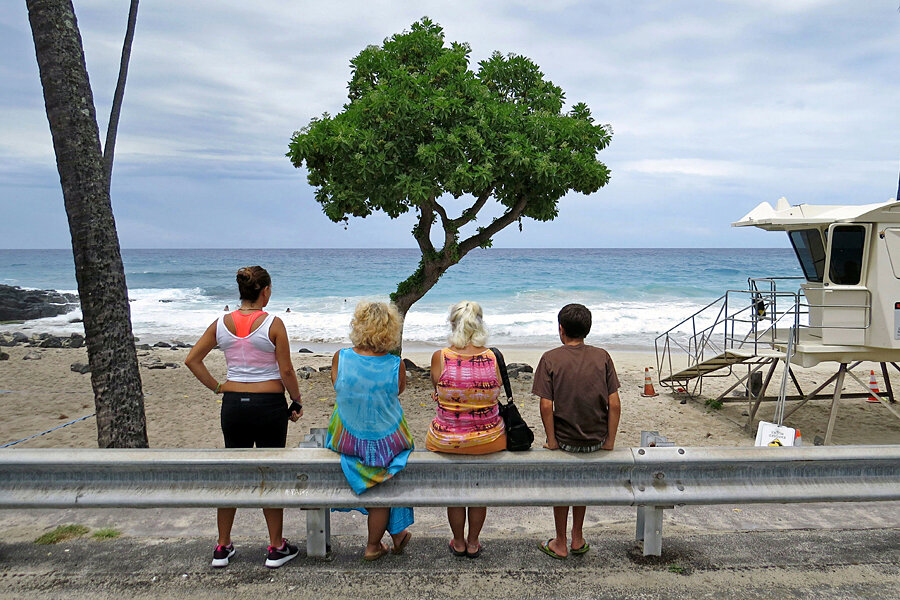Hawaii's big lesson from hurricane weekend: Stay prepared
Loading...
| Los Angeles
As hurricane Julio heads away from Hawaii Monday, it appears that the tropical island state has dodged serious impact from a threatened double storm hit. Tropical storm Iselle – downgraded from a hurricane – landed on the Big Island Friday, dropping heavy rains and knocking out power for thousands.
But by Friday evening, tourists were back on the beaches and the only curveball in Saturday’s state election was the surprise upset of Gov. Neil Abercrombie in the Democratic primary. By Monday, Julio’s possible impact had weakened considerably, and the only minor fallout appears to be the unseasonable appearance of hot, muggy temperatures in Julio’s wake.
But while the island is quickly returning to a normal vacationer’s paradise, there are important lessons from the state’s brush with unprecedented back-to-back storms.
“Most important lesson is that these sorts of events can in fact happen,” says Mark Paquette, senior meteorologist at AccuWeather, based in State College, Pa.
Despite its prime tropical island location, Hawaii has been remarkably free of major storms. The last time a hurricane hit was 22 years ago, and the Big Island has not recorded a hurricane hit since its official weather tracking began in the 1950s. “So the important message is that storms can happen anywhere,” he says, and it’s important not to become complacent.
In fact, Hawaii conducts annual emergency drills across the islands. Save the Children gives the island state high marks for being one of only 22 states to have a comprehensive K-12 disaster preparedness program.
Hawaii has a high likelihood for multiple types of disasters, including earthquakes, tsunamis, hurricanes, and even volcanic eruptions, points out Rich Bland, Save the Children’s national director of policy and advocacy. “The state was right to insist on ‘multi-hazard’ plans for all schools, and comprehensive emergency plans for child care,” he says via e-mail, adding that many other states could learn from Hawaii.
“More and more, communities around the country are vulnerable to a multitude of emergencies,” notes Mr. Bland. They need to prepare accordingly, he says, including running very different types of drills for different scenarios. “One size does NOT fit all,” he adds. “And Hawaii could teach others that fact.”
The threat of such unheard-of storms in the tropical paradise spotlights the importance of even broader preparedness, says Karl Rabago, the director of the Pace Law School Energy and Climate Center in White Plains, N.Y. “The big risk here is confusing climate and weather,” he says via e-mail. “The weather was not as bad as we predicted,” he says, but notes that overall, “The climate is getting really bad – two back-to-back storms!”
Longer-term changes and preparations for both climate change and bad weather can bring twin benefits of “increased reliability, reduced pollution, reduced dependence on imported fuels.” And these are a win-win that should be part of any larger preparedness strategy, he adds.
A Maui vacationer relates just how prepared Hawaii was:
“The advance preparations went off flawlessly on Maui. Supplies in stores were constantly restocked, no mean thing given that most goods flow between the islands on barges,” says Char Miller, a professor at Pomona University via e-mail.
Professor Miller chatted with the pilot of a container-carrying vessel just before Iselle plowed into the Big Island, and the pilot was matter-of-fact about maintaining the supply chain.
The emergency preparations in the end were not reality tested, as Iselle dealt only a glancing blow to Maui, Miller notes.
“By Friday afternoon the skies were clearing and people were swimming, snorkeling, and surfing in the bathtub-warm Pacific,” he says. A further reflection of the calm on the islands was that the political primary elections went off without a hitch during this period, he adds. Only two precincts were shut down in the aftermath of Iselle. “All this a reflection of careful disaster management in the post superstorm Sandy era,” he adds.







